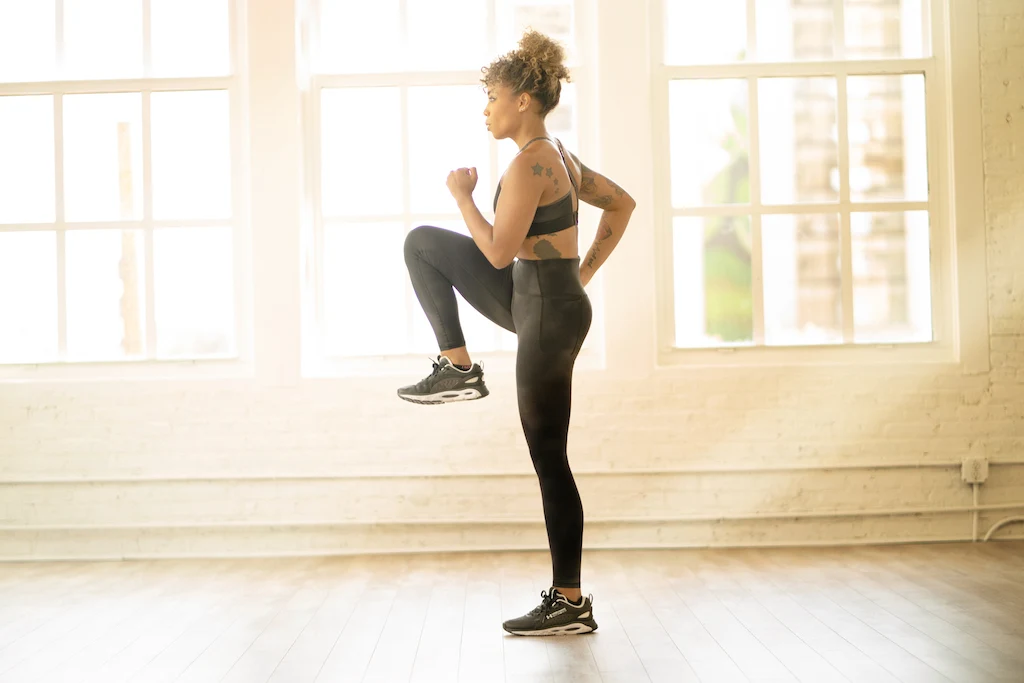How To Do HIIT For Beginners

February 14, 2020


If you lead a busy lifestyle and don’t have much time for exercise, high-intensity interval training, or HIIT, is a training style you might want to consider adding to your workout routine.
HIIT workouts are a fast and effective way to increase your fitness. You’ll push your body hard for a short time, rest and repeat for a number of rounds — then you’re done!
If you’ve never tried high-intensity interval training or are a fitness beginner, here’s a guide to help you smash your first HIIT workout.
What is HIIT?
High-intensity interval training is a fast-paced training style that involves short and intense bursts of exercise. Most workouts will typically take you between 15-45 minutes and can be completed at home, in the gym, using equipment or with bodyweight alone.
How to start HIIT
Anyone can benefit from HIIT and you don’t have to be an athlete to get started. However, if you're new to HIIT and aren't sure if it's the right fit for you, seek guidance from fitness or healthcare professionals to make sure it's suitable for you.
If you're new to fitness and are working out with the Sweat app, find a HIIT program that fits your health and fitness goals as a beginner. Head Trainer Kayla Itsines' High Intensity and High Intensity Zero Equipment programs both start with Beginner weeks to help build your full-body strength and get comfortable with the training style.
Another way you can work towards including HIIT workouts in your routine is to start with some steady-state cardio and strength work.
Do this for four to eight weeks to build your baseline fitness, and once you’re used to training regularly, you may feel more confident to give a HIIT workout or a whole new training program a go!
Be prepared to push yourself, but know that your effort only needs to be short! As you get fitter and stronger you'll start to find you can sustain your high-intensity effort for longer.
How often should you do HIIT?
The number of HIIT workouts you do each week will depend on what other training you're doing, where you are in your fitness journey and whether you're following a structured program.
According to the American College of Sports Medicine, as a beginner, you can “start with one HIIT workout a week, with your other workouts being steady-state workouts.” Not sure where to start? Take a look at some of the HIIT workouts available in the On Demand section of the Sweat App. Express HIIT with Chontel Duncan is a favourite amongst the Sweat Community, and will only take you 10 minutes!
Once you feel ready, try adding a second HIIT workout into your week, ensuring you spread these sessions out to allow enough time for recovery.
Always remember to listen to your body and avoid pushing yourself too much, especially when you are trying something new. The last thing you want is an injury or burnout!
If you're doing strength training or other forms of exercise throughout the week, try challenging yourself by switching one of your low-intensity cardio sessions for a HIIT workout.
If you’re following one of the programs in the Sweat app, simply choose a high-intensity cardio session. There’s a timer for your work-rest intervals that will help keep you on track.

How long is a HIIT workout?
A HIIT workout can be as short or as long as you make it! As a beginner, a good place to start is with 10-15 minutes, and you can increase the number of intervals for a longer workout as your fitness improves.
If you are trying HIIT for the first time, slowly build your work to recovery ratio — you might start with 15 seconds of work to 45 seconds of recovery and over a number of weeks work towards 45 seconds of work to 15 seconds of recovery.
For example, a Tabata workout has a structure of 20 seconds of all-out effort, followed by 10 seconds of rest. You then repeat this sequence eight times over — for an intense workout of just four minutes!
During these short bouts of work, you should aim to reach an RPE (rate of perceived exertion) of 8. Your RPE is a way for you to subjectively measure how hard an exercise feels using a scale of 1-10. The higher you rate the exercise, the more challenging you find it!
Is high-intensity training always high-impact?
A HIIT session doesn’t have to be high-impact. A common misconception is that HIIT always involves plyometric exercises like burpees and skipping, but you can do HIIT sprints using an elliptical machine, rower, laps in a swimming pool, or exercises that don't involve jumping.
Low impact HIIT involves exercises that don’t put a strain on your tendons and joints making it a more accessible option for beginners or anyone that would rather avoid high-impact movements. Remember, it’s about how hard you work, not how hard you hit the ground!
What to expect during your first HIIT workout
During your first HIIT workout, aim to give it your maximum effort for the first couple of intervals, or if this feels too much, start with 70% effort until you feel comfortable with each movement, then ramp it up during your next session.
Don’t feel discouraged if you can’t keep going at maximum effort — it's meant to be tough and it can take time to build up your fitness and strength. Be patient and stay consistent, and over time you’ll be able to complete more intervals at your best effort.
You can connect with the Sweat Community if you need support or want to share how you are going on your journey.
Should you eat before a HIIT workout?
When and what you eat before you exercise can affect how you feel during and after the workout. A pre-workout meal three or four hours before your workout, or a light snack like a banana 30 minutes before your workout, might help provide you with the energy you need to get the most out of your first HIIT session. Allowing time between your meal and your workout will also help to ensure you won’t feel sick during your session.
You should follow your workout with a high-energy snack or a balanced meal that includes carbohydrates and protein to help replace the energy burned during your workout and to support muscle recovery.
If you enjoy morning workouts but don't like to eat before your session (or don't have the time!), make sure to have a balanced meal the night before, and follow your workout with a nutritious breakfast.

How to nail your first HIIT workout
Now that you know what to expect, here are some tips to get the most out of your first HIIT workout.
Practise correct form
Make sure you're familiar with the correct form for each exercise during your workout and modify them if you need to.
If you’re following a Sweat Program or On Demand workout, there are exercise descriptions and video demonstrations available, as well as the option to swap the exercises if you need to change the intensity or modify a workout to suit your body.
Wear the right shoes
The shoes you wear when lifting weights might not be ideal for HIIT, so it’s best to get fitted correctly. This will ensure you provide your feet and the rest of your body with the right support during your workout.
Do a proper warm-up
Warming up thoroughly before starting any workout can reduce the risk of injury and ensure your body is ready for the movement you are about to do!
Use lighter weights
If your HIIT workout utilises free weights, reduce the weight you might normally lift during a slower, strength workout so you can complete more reps with the proper form.
Exercise at the correct intensity
You’ll get the most out of HIIT when you put in maximum effort during your workouts. By keeping the work intervals short, you should aim to reach an RPE of 8-9 for each interval.
According to Mayo Clinic in the US, there are a few ways you can determine whether you’re exercising at the right intensity, including monitoring your heart rate. The way you breathe during your workouts can also indicate whether you’re pushing yourself hard enough. During a HIIT workout, you should not be able to hold a conversation!
Allow time for recovery
As with any form of exercise, HIIT may lead to injuries if you don’t take precautionary steps before, during and after your workout to ensure you take care of your body.
It’s essential to allow enough time for recovery between each session. As a general rule, you should allow 24-48 hours between high-intensity workouts, depending on their duration and how your body feels afterwards.
Use HIIT to reach your fitness goals
When you don’t have time for a long workout, 10 minutes of HIIT can elevate your heart rate and help you maintain your fitness momentum!
HIIT can be a great option if you're pushed for time or can’t get to the gym and you don’t even need any equipment to get started.
Despite its popularity and benefits, HIIT isn't for everyone. If this training style doesn’t appeal to you, remember you can reach your fitness goals with other forms of exercise — the best way to move your body is to find a workout you enjoy.
Now that you have an idea of how to get started with high-intensity interval training, what are you waiting for? Plan your first HIIT workout today!

A more empowered you starts with Sweat, and our editorial team is here to bring you the latest fitness tips, trainer recommendations, wellbeing news, nutritional advice, nourishing recipes and free workouts.
* Disclaimer: This blog post is not intended to replace the advice of a medical professional. The above information should not be used to diagnose, treat, or prevent any disease or medical condition. Please consult your doctor before making any changes to your diet, sleep methods, daily activity, or fitness routine. Sweat assumes no responsibility for any personal injury or damage sustained by any recommendations, opinions, or advice given in this article.
Fitness